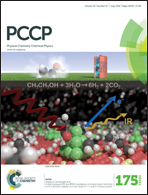Biophysical insights into the membrane interaction of the core amyloid-forming Aβ40 fragment K16–K28 and its role in the pathogenesis of Alzheimer's disease†
Abstract
The aggregation of amyloid-β (Aβ) on neuronal membranes is implicated in both neuronal toxicity and the progression of Alzheimer's disease. Unfortunately, the heterogeneous environment that results from peptide aggregation in the presence of lipids makes the details of these pathways difficult to interrogate. In this study, we report an investigation of the membrane interaction of an Aβ fragment (K16LVFFAEDVGSNK28, KK13), which maintains the amyloidogenic nature of the full-length peptide and is implicated in membrane-mediated folding, through a combination of NMR spectroscopy and molecular dynamics simulations. Despite KK13's ability to form amyloids in solution, the monomer remains unstructured in the presence of lipid bilayers, unlike its full-length parent peptide. Additionally, NMR and molecular dynamics simulation results support that the presence of GM1 ganglioside, a lipid which strongly promotes binding between Aβ and lipid bilayers, promotes KK13 binding to but not folding on the membrane. Finally, we show that the peptide partitions between the membrane and aqueous solution based on the hydrophobicity of the N-terminal residues, regardless of lipid composition. These results support previous discoveries suggesting the importance of GM1 ganglioside in exacerbating membrane-driven aggregation while identifying the potential importance of C-terminal residues in membrane binding and folding, which has previously been unclear.


 Please wait while we load your content...
Please wait while we load your content...